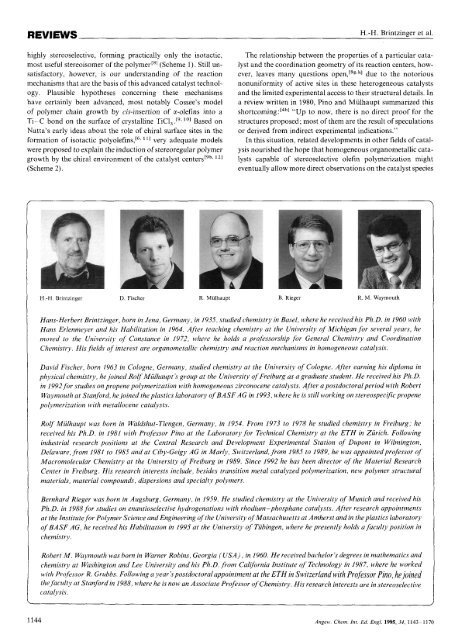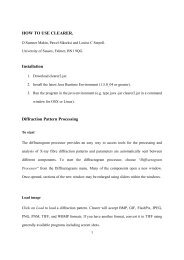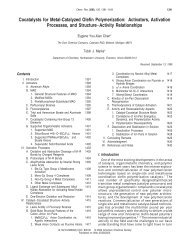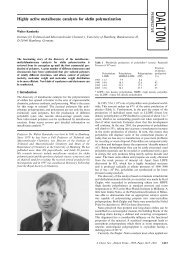Stereospecific Olefin Polymerization with Chiral Metallocene Catalysts
Stereospecific Olefin Polymerization with Chiral Metallocene Catalysts
Stereospecific Olefin Polymerization with Chiral Metallocene Catalysts
Create successful ePaper yourself
Turn your PDF publications into a flip-book with our unique Google optimized e-Paper software.
REVIEWS<br />
highly stereoselective, forming practically only the isotactic,<br />
most useful stereoisomer of the polymer[8] (Scheme 1). Still un-<br />
satisfactory, however, is our understanding of the reaction<br />
mechanisms that are the basis of this advanced catalyst technol-<br />
ogy. Plausible hypotheses concerning these mechanisms<br />
have certainly been advanced, most notably Cossee’s model<br />
of polymer chain growth by cis-insertion of n-olefins into a<br />
Ti-C bond on the surface of crystalline TiCI, .I9, lo] Based on<br />
Natta’s early ideas about the role of chiral surface sites in the<br />
formation of isotactic p~lyolefins,[~, very adequate models<br />
were proposed to explain the induction of stereoregular polymer<br />
growth by the chiral environment of the catalyst centersrgb,<br />
(Scheme 2).<br />
H.-H. Brintzinger et al.<br />
The relationship between the properties of a particular catalyst<br />
and the coordination geometry of its reaction centers, however,<br />
leaves many questions open,[8g3 h] due to the notorious<br />
nonuniformity of active sites in these heterogeneous catalysts<br />
and the limited experimental access to their structural details. In<br />
a review written in 1980, Pino and Mulhaupt summarized this<br />
shortcoming:r4b] “Up to now, there is no direct proof for the<br />
structures proposed; most of them are the result of speculations<br />
or derived from indirect experimental indications.”<br />
In this situation, related developments in other fields of catalysis<br />
nourished the hope that homogeneous organometallic catalysts<br />
capable of stereoselective olefin polymerization might<br />
eventually allow more direct observations on the catalyst species<br />
H.-H. Brintzinger D. Fischer R. Mulhaupt B. Rieger R. M. Waymouth<br />
Hans-Herbert Brintzinger, born in Jena, German),. in 1935, studied chemistry in Basel, where he received his Ph.D. in 1960 <strong>with</strong><br />
Hans Erlenmeyer and his Habilitation in 1964. After teaching chemistry at the University of Michigan for several years, he<br />
moved to the University of Constance in 1972, where he holds a professorship ,for General Chemistry and Coordination<br />
Chemistry. His ,fields of interest are organometallic chemistry and reaction mechanisms in homogeneous catalysis.<br />
David Fischer, born 1963 in Cologne, Germany, studied chemistry at the University of Cologne. ,4fter earning his diploma in<br />
physical chemistry, he joined Rolf Mulhaupt 2. group at the University of Freiburg as a graduate student. He received his Ph.D.<br />
in 1992for studies on propene polymerization <strong>with</strong> homogeneous zirconocene catalysts. After a postdoctoral period <strong>with</strong> Robert<br />
Waymouth at Stanford, he joined the plastics laboratory of BASF AG in 1993, where he is still working on stereospecific propene<br />
polymerization <strong>with</strong> metallocene catalysts.<br />
Rolf Miilhaupt was born in Waldshut-Tiengen, Germany, in 1954. From 1973 to 1978 he studied chemistry in Freihurg; he<br />
received his Ph.D. in 198f <strong>with</strong> Professor Pino at the Laboratory for Technical Chemistry at the ETH in Zurich. Following<br />
industrial research positions at the Central Research and Development Experimental Station of Dupont in Wilmington,<br />
Delaware, from 1981 to 1985 and at Ciby-Geigy AG in Marly, Switzerland,Jion? 1985 to 1989, he was appointedprofessor of<br />
Macromolecular Chemistry at the University of Freiburg in 1989. Since 1992 he has been director of the Material Research<br />
Center in Freiburg. His research interests include, besides transition metal catalyzed polymerization, new polymer structural<br />
materials, material compounds, dispersions and specialty polymers.<br />
Bernhard Rieger was born in Augsburg, Germany, in 1959. He studied chemistry at the University of Munich and received his<br />
Ph.D. in 1988 for studies on enantioselective hydrogenations <strong>with</strong> rhodium-phosphane catalysts. After research appointments<br />
at the Institute for Polymer Science and Engineering ofthe University ?f Massachusetts at Amherst and in the plastics laboratory<br />
of BASF AG. he received his Habilitation in 1995 at the University of Tubingen, klhere he presently holds a faculty position in<br />
chemistry.<br />
Robert M. Waymouth was born in Warner Robins, Georgia (USA), in 1960. He received bachelor’s degrees in mathematics and<br />
chemistry at Washington and Lee University and his Ph.D. from California Institute of Technology in 1987, where he worked<br />
uith Professor R. Grubbs. Following n year ’spostdoctoral appointment at the ETH in Switzerland <strong>with</strong> Professor Pino, he joined<br />
the faculty at Stanford in 1988, where he is now an Associate Professor of Chemistry. His research interests are in stereoselective<br />
catalysis.<br />
1144 Angew. Cliem. Inr. Ed. Enxl. 1995,34, 1143-1170






